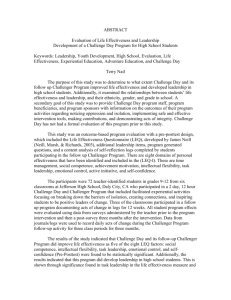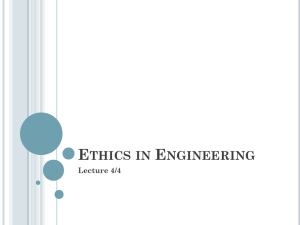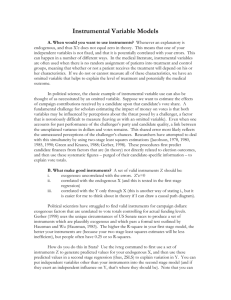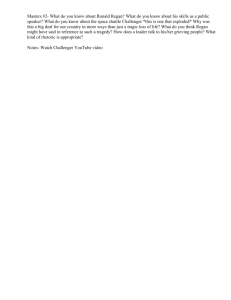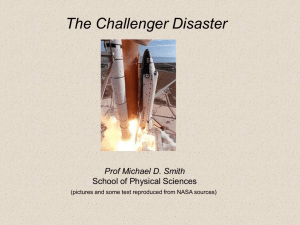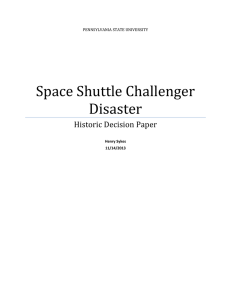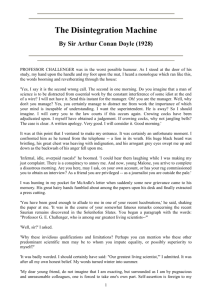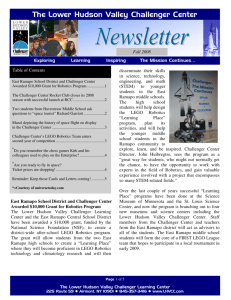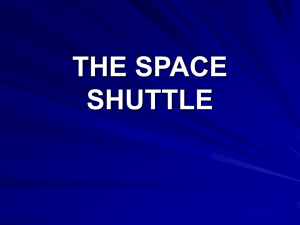Space Shuttle Challenger
advertisement
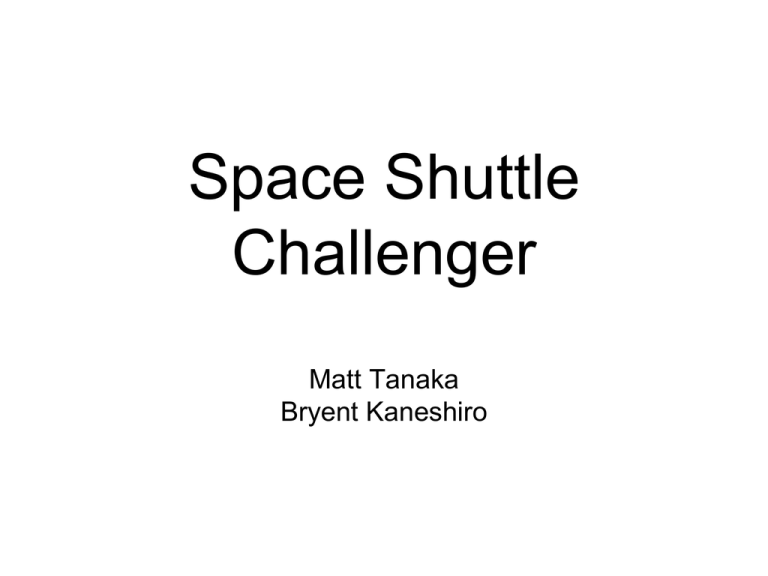
Space Shuttle Challenger Matt Tanaka Bryent Kaneshiro What is the space shuttle challenger??? • • • This was NASA’s second space shuttle orbiter to be put into service. The shuttle was built in Rockwell’s International Space Transportation Systems Division in Downey, California. It was named after the Apollo 17 lunar model, named Challenger, which landed on the moon in 1972 • • Challenger was one of the most successful space shuttles because it flew on 85% of all space shuttle missions. It featured many spaceflight accomplishments such as having the first American woman, first african american, and canadian in space. Space Shuttle Challenger Disaster • • On January 28, 1986, the space shuttle Challenger broke apart 73 seconds after take off, leading to the deaths of seven crew members. The spacecraft exploded over the Atlantic Ocean, off the coast of central Florida. • • • • Disintegration of the spacecraft began after an o-ring seal in its right solid rocket booster failed at liftoff. The o-ring failure caused a breach in the solid rocker booster joint it sealed, allowing pressurized hot gas from within the solid rocket motor to reach the outside and affect upon the adjacent solid rocket booster attachment hardware and external fuel tanks. This led to the separation to the right solid rocket booster attachment and structural failure of external tank. Aerodynamic forces quickly broke up Challenger. 7 Astronauts 1. The spacecraft commander was Francis R. Scobee • He was born on May 19, 1939, in Cle Elum, Washington, and graduated from the public high school in Auburn, Washington, in 1957. In 1965 completed a B.S. degree in Aerospace Engineering from the University of Arizona. 2. The pilot was Michael J. Smith • born on April 30, 1945 in Beaufort, North Carolina. Smith had been educated at the U.S. Naval Academy and received an M.S. in Aeronautical Engineering from the Naval Postgraduate School in 1968. 3. Judith A. Resnik was one of three mission specialists on Challenger. • Born on April 5, 1949 at Akron, Ohio, a respected Akron optometrist. Attending Carnegie-Mellon University, where she received a B.S. in electrical engineering in 1970, and the University of Maryland, where she received Ph.D in 1977. 4. Ronald E. McNair was the second of three mission specialists aboard Challenger. Born on October 21, 1950 in Lake City, South Carolina. He achieved early success in the segregated public schools he attended as both a student and an athlete. Attended North Carolina A&T State University where in 1971 he received a B.S. degree in physics where he specialized in quantum electronics and laser technology, completing his Ph.D. In 1977. 5. Ellison S. Onizuka, was the last of the three mission specialists. He had been born in Kealakekua, Kona, Hawaii, on June 24, 1946, of Japanese-American parents. He attended the University of Colorado, receiving B.S. and M.S. degrees in engineering in June and December 1969, respectivelyHe also participated in the Air Force R.O.T.C. program, leading to a commission in January 1970. Onizuka served on active duty with the Air Force until January 1978 when he was selected as a NASA astronaut. 6. Gregory B. Jarvis, a payload specialist Worked for the Hughes Aircraft Corp.'s Space and Communications Group in Los Angeles, California, and had been made available for the Challenger flight by his company.Jarvis had been born on August 24, 1944, in Detroit, Michigan. 7. The last member of the crew was Sharon Christa McAuliffe, the first teacher to fly in space. Selected from among more than 11,000 applicants from the education profession for entrance into the astronaut ranks, McAuliffe had been born on September 2, 1948. McAuliffe attended Framingham State College in her hometown, graduating in 1970. She took a job teaching in the secondary schools, specializing in American history and social studies. Before The Takeoff Liftoff was initally scheduled from at 3:43 p.m. EST on January 22, 1986. then Jan. 24, due to delays in mission 61-C and finally reset for Jan. 25 because of bad weather at transoceanic abort landing (TAL) site in Dakar, Senegal. The launch was again postponed for one day when launch processing was unable to meet new morning liftoff time. Predicted bad weather at Kennedy Space Center (KSC) caused the launch to be rescheduled for 9:37 a.m. EST, Jan. 27, but it was delayed another 24 hours when ground servicing equipment hatch closing fixture could not be removed from orbiter hatch. The fixture was sawed off and an attaching bolt drilled out before closeout completed. During this delay, the cross winds exceeded limits at KSC's Shuttle Landing Facility. There as a final delay of two hours when a hardware interface module in the launch processing system, which monitors fire detection system, failed during liquid hydrogen tanking procedures. The Challenger finally lifted off at 11:38:00 a.m. EST. The Explosion When the spaceship blew up, there was no shock wave, no detonation, no "bang" — viewers on the ground just heard the roar of the engines stop as the shuttle’s fuel tank tore apart, spilling liquid oxygen and hydrogen which formed a huge fireball at an altitude of 46,000 ft. But both solid-fuel strap-on boosters climbed up out of the cloud, still firing and unharmed by any explosion. Challenger itself was torn apart as it was flung free of the other rocket components and turned broadside into the Mach 2 airstream. Individual propellant tanks were seen exploding — but by then, the spacecraft was already in pieces. The flight, and the astronauts’ lives, did not end at that point, 73 seconds after launch. After Challenger was torn apart, the pieces continued upward from their own momentum, reaching a peak altitude of 65,000 feet before arching back down into the water. The cabin hit the surface 2 minutes and 45 seconds after breakup, and all investigations indicate the crew was still alive until then. But once the cabin hit the water greater than 200mph everything inside would be crushed and killing the astronauts. The Aftermath The reaction was immediate, from the crowds of family and friends gathered to watch the launch of the Space Shuttle Challenger, to the millions tuned in worldwide, most people were stunned. In a speech later that day, President Ronald Reagan expressed the feelings of many who were grieving. All shuttle missions were halted while a special commission appointed by President Reagan determined the cause of the accident and what could be done to prevent such disasters from happening again. Works Cited http://www.msnbc.msn.com/id/11031097/ns/technology_and_sciencespace/ http://en.wikipedia.org/wiki/Space_Shuttle_Challenger_disaster http://history.nasa.gov/Biographies/challenger.html http://en.wikipedia.org/wiki/Space_Shuttle_Challenger http://space.about.com/cs/challenger/a/challenger_2.htm http://www.aerospaceguide.net/spaceshuttle/challenger_disaster.html
